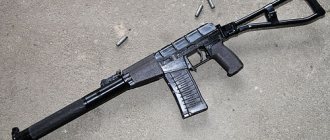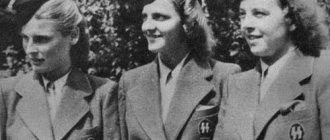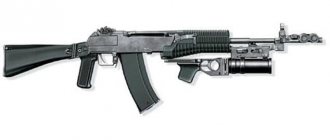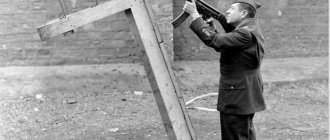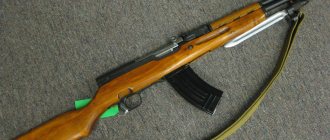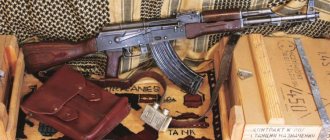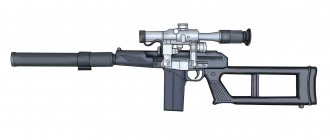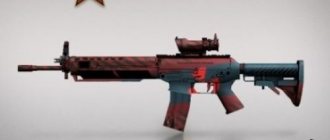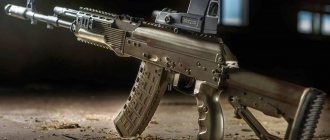The first Russian assault rifle: Fedorov assault rifle
The Fedorov assault rifle, also known as the Fedorov automatic rifle, is a Russian 2.5-line (6.5 mm) automatic rifle that was created by Russian army captain Vladimir Grigorievich Fedorov in 1913-1916. In fact, this was the first machine gun that was created in Russia. The weapon had limited use, however, it managed to take part in the Winter War with Finland. The Fedorov assault rifle became the predecessor of modern infantry automatic weapons.
Captain of the Russian Imperial Army Vladimir Fedorov began work on creating a self-loading rifle in 1906. His first rifle was created for the standard Russian cartridge of the famous three-line - 7.62x54R and was equipped with a magazine designed for 5 rounds. Tests of this self-loading rifle were carried out in 1911, and in 1912 it was even decided to order an experimental batch of weapons - 150 rifles, which were planned to be sent for military testing.
Military tests of Fedorov's self-loading rifle were successful, but it never entered service. The rifle he created weighed 600 grams more than the three-ruler, and its magazine capacity remained the same as that of the Mosin rifle. Moreover, all attempts to reduce the weight of the rifle led to a decrease in its structural strength and reliability. Therefore, Fedorov simply continued to work, but on creating a new weapon, this time chambered for his own cartridge, of a smaller caliber, which was also supposed to solve the problem with the weight of the weapon.
Fedorov chose a 6.5 mm cartridge for his automatic rifle. This cartridge had a pointed bullet of 6.5 mm caliber, which weighed 8.5 grams, as well as a bottle-shaped cartridge case without a protruding rim. The initial flight speed of such a bullet was at the level of 850 m/s, which provided a muzzle energy of 3100 J. For example, the 7.62x54R rifle cartridge had a muzzle energy of 3600-4000 J, depending on the equipment option.
From the presented characteristics we can conclude that the cartridge created by Fedorov was not “intermediate” in the modern sense - it was a fully-fledged rifle cartridge of a reduced caliber (for comparison: the muzzle energy of an intermediate cartridge 7.62x39 mm is about 2000 J). At the same time, Fedorov’s cartridge provided a lower recoil impulse compared to a standard 7.62 mm rifle cartridge, had less weight and was much more suitable for use in automatic weapons.
The high initial velocity of the bullet allowed the designer to reduce the length of the barrel and reduce the size of the weapon to approximately one meter. In terms of its combat qualities, Fedorov’s development turned out to be something intermediate between an automatic rifle and a light machine gun. For this reason, at the suggestion of the inventor himself, it was proposed to give the development a new name - machine gun.
Testing of Fedorov's new development began at the end of 1913, but the outbreak of the First World War put an end to research in the field of new cartridges. However, already in 1915, the Russian army began to experience an urgent need for small arms, including light machine guns. Quite a large number of small arms were lost in battles. Therefore, they returned to the Fedorov automatic rifle again, deciding to order it as a light infantry support weapon. The need for such weapons was prompted by the very nature of military operations, which had changed significantly in comparison with the wars of the past.
Making the decision to resume production of the Fedorov assault rifle, we decided to convert it to the Japanese 6.5x50SR Arisaka cartridge, which had characteristics similar to the Fedorov cartridge. The Russian army already had these cartridges in significant quantities. They were acquired along with Japanese Arisaka rifles already during the war to make up for losses in weapons. At the same time, the already released machine guns were simply going to be converted to use the Japanese cartridge by installing a special insert in the chamber.
Options and modifications
- Self-loading rifle Fedorov model 1907, caliber 7.62 × 54 mm R, integrated magazine for 5 rounds, based on the Mosin rifle
[10]. - Self-loading rifle Fedorov model 1912, caliber 7.62 × 54 mm R, detachable magazine for 5 rounds, independently developed by Vladimir Fedorov
[10]. - Fedorov automatic rifle, model 1913, caliber 6.5 × 57 mm Fedorov cartridge, detachable box magazine for 5 rounds, independently developed by Vladimir Fedorov
[10]. - Fedorov assault rifle model 1916, caliber 6.5 × 50 mm Arisaka, detachable box-shaped sector magazine for 25 rounds, independently developed by Vladimir Fedorov
[10]. - Fedorov assault rifle model 1916, caliber 6.5 × 50 mm Arisaka, detachable box-shaped sector magazine for 25 rounds, folding bipod, no front handle, independent development of Vladimir Fedorov
[10].
In addition, in the first half of the 1920s, based on the design of the Fedorov assault rifle, a family of standardized small arms that were not mass-produced was developed:
- 6.5-mm Fedorov-Degtyarev light machine gun,
model 1921, with a water-cooled barrel, similar to a Maxim machine gun, a bipod and a box-shaped sector magazine for 25 rounds; - 6.5-mm Fedorov-Degtyarev light machine gun
model 1921 with a radiator similar to a Lewis machine gun with air-cooled barrel, bipod and box-shaped sector magazine for 25 rounds; - 6.5-mm Fedorov-Degtyarev light machine gun
model 1922 with air-cooled barrel, similar to a Madsen machine gun, bipod and box-shaped sector magazine for 25 rounds; - 6.5-mm Fedorov-Degtyarev light machine gun,
model 1922, with an air-cooled barrel and a disc magazine for 50 rounds; - A 6.5-mm Fedorov-Degtyarev aircraft machine gun,
model 1922, with an air-cooled barrel and a disk magazine for 50 rounds, was installed on the I-1 Polikarpov, I-2 Grigorovich, R-1 Polikarpov and MP-1 Polikarpov aircraft; - 6.5-mm coaxial aircraft machine gun Fedorov - Degtyarev
model 1922 with air-cooled barrels and two disk magazines for 50 rounds, installed on the I-1 Polikarpov, I-2 Grigorovich, R-1 Polikarpov and MP-1 Polikarpov aircraft; - 6.5-mm coaxial light machine gun Fedorov - Shpagin
model 1922 with air-cooled barrels, bipod and two box-shaped section stores located at the top for 25 rounds; - A 6.5-mm built Fedorov-Shpagin aircraft machine gun,
model 1925, with air-cooled barrels and three disc magazines for 50 rounds, was installed on the I-1 Polikarpov, I-2 Grigorovich, R-1 Polikarpov and MP-1 Polikarpov aircraft; - 6.5-mm coaxial tank machine gun Fedorov - Shpagin - Ivanov
model 1925 with air-cooled barrels and two box-shaped sector magazines for 25 rounds located at the top, installed on the T-18 tank and the BA-27 armored car; - 7.62-mm Fedorov-Degtyarev light machine gun,
model 1925, with an air-cooled barrel, bipod and box-shaped sectional magazines for 25 rounds located at the top, a deep modification of the Fedorov-Degtyarev light machine gun, model 1922, direct predecessor of the DP-27 light machine gun; - 7.62-mm Fedorov-Simonov automatic rifle,
model 1925, with box-shaped section magazines for 15 rounds, a deep modification of the Fedorov automatic rifle, model 1912, direct predecessor of the ABC-36 automatic rifle.
Speculation[edit]
Fedorov's assault rifle has been the subject of many years of speculation. The main thesis of speculation is the exclusion of the assault rifle from this class of weapons and the deprivation of the designer in particular and the country as a whole of priority for it. The breeding ground is the almost complete silence about it over a very long period - until 1991. Over the past 25 years, this gap has been filled with printed, electronic and other materials, which often do not correspond to reality. It is curious that the arena of speculation is predominantly Russia.
- Use of imported ammunition. The fact of domestic production of the 6.5x51 cartridge is hushed up.
- Using a rifle cartridge. Based on this, the Fedorov assault rifle is classified as a class of self-firing rifles (ABC-36, SVT-40) that have shown themselves to be a dead-end branch of weapons.
- Similar caliber ammunition is gaining popularity. In this case, a thesis is put forward about a certain difference in technology.
From rifle to machine gun[ | ]
Cartridge 6.5x50 mm Arisaka
With the outbreak of the First World War, all work on new types of weapons was suspended. Fedorov himself was sent abroad to purchase rifles.
In January 1916, Colonel V. G. Fedorov, who returned to Russia, particularly addresses the issue of automatic weapons: “It is not automatic rifles that are being ordered, but submachine guns, which, in my opinion, ... are currently of undoubtedly greater importance than those mentioned rifles... Even if we had... a complete automatic rifle... it would be inappropriate to establish its production in factories... I believe that for our army the only question is the need for the widest testing in combat conditions of various systems of submachine guns and automatic rifles, moreover... it is necessary to immediately order a certain quantity of up to 3 or 5 thousand automatic rifles, adapted for continuous shooting and having a magazine for 20–25 rounds... To set up production, it is necessary to look for a private workshop”[5].
In the workshops of the Rifle Range of the Officer Rifle School, Fedorov began converting his system into a submachine gun (as light machine guns were then called). Here, in the summer of 1915, the head of the school, General N. M. Filatov, requested the school to supply parts of the 7.62 mm Fedorov rifle of 1912 and the 6.5 mm rifle of 1913 and achieved the transfer of Fedorov’s chief assistant from the Sestroretsk plant in work on the rifle V. A. Degtyareva. Fedorov introduced into the system a flag translator for automatic fire, a movable bolt cover, and developed a series of interchangeable magazines[5].
There could be no question of mastering and mass production of Fedorov’s new cartridge, and the designer adapted his rifle for the even weaker Japanese cartridge 6.5x50 mm Arisaka with a muzzle energy of 2615 J. These cartridges were purchased by the government along with Japanese Arisaka rifles and were available in warehouses in significant quantities. The main manufacturers of Japanese-style cartridges for Russia were English companies - Kaynok, the Royal Arsenal of Woolwich, as well as the Petrograd Cartridge Plant (200-300 thousand per month, according to the factory museum).
The Arisaka cartridge, when fired from the Fedorov Automatic, had a muzzle energy of 1960 J, and it was this value that was included in the technical specifications for a new intermediate cartridge for several caliber options - 5.6 mm, 6.5 mm and 7.62 mm, but with a shorter barrel. The Japanese cartridge was smaller than Fedorov's, and rifles were adapted for it by inserting a special insert into the chamber.
The bolt was locked by two swinging larvae, located symmetrically on both sides and rotating in a vertical plane. During the shot, when the barrel moved back, these larvae turned and released the bolt, which could then freely move to the rearmost position.
At the Oranienbaum Officer Rifle School, a company of the 189th Izmail Infantry Regiment, consisting of 158 soldiers and 4 officers, was armed with Fedorov submachine guns and automatic rifles, which, after completing training on December 1, 1916, was sent to the Romanian Front [1]. According to the Journal of the 5th Department of the Artcom of the GAU No. 381 dated September 6, 1916, the company was given:
- 8 pcs. 6.5 mm submachine guns (machine guns) with 15-round magazines,
- 45 pcs. 3-line automatic (self-loading) rifles (several of them were adapted to install a magazine from a Madsen machine gun and fire in bursts)[6]
On the Romanian front, Fedorov assault rifles were used for the first time during combat operations[7]. The question arose about arming the army with new weapons.
Head of the GAU General A.A. On October 23, 1916, Manikovsky ordered the organization of production of 15,000 Fedorov automatic rifles at the state-owned Sestroretsk plant, first in a semi-handicraft manner, followed by a transition to “machine fabrication”, in the production of rough barrels by the Izhevsk steelmaking plant, and boxes by the Putilov plant. The head of the Sestroretsk plant proposed to involve private Petrograd factories, and carry out assembly and debugging at the Rifle Range. In mid-1917, a commission was formed to prepare the production of Fedorov’s “manual submachine gun.” But the Sestroretsk plant failed to obtain the necessary machines, so organizing new production here was very difficult. Then, in October 1917, a machine gun factory under construction in the city of Kovrov, equipped with completely modern equipment, was chosen for the production of Fedorov rifles[5].

